CONVEX MIRROR
Convex spherical mirrors are made from a section of an outer silvered ball.
The image formed in a convex mirror is always erect, virtual and diminished in size.
Constructing a ray diagram for a convex mirror
A ray travelling parallel to the principal axis virtually emanates from the virtual focal point after reflection by the mirror. To draw the reflected ray you have to put your ruler on the principal focus on the far side of the mirror and the point where the ray hits the mirror. Draw a dashed line from the virtual focus point to the mirror edge and then a solid line for the reflected ray.
A ray that aims at the virtual centre of curvature of the mirror is reflected back along its own path. Put your ruler on the object point and at C (or 2F) on the far side of the mirror. Draw a dashed line from C to the mirror and then a solid line to represent the ray that gets reflected back along its own path.
A ray that aims at the virtual focal point as it goes towards the mirror will be reflected back along a path parallel to the principal axis Put your ruler on the object point and the far focal point. Draw a solid line to represent the incident ray from the object point to the mirror and then a dotted line to the focus. Now draw a reflected ray that goes from the point your incident ray hit the mirror parallel to the principal axis. Continue that with a dashed line on the far side of the mirror.
The point where these three dashed lines meet is the image point. See the examples below:
1. Obeject beyond C
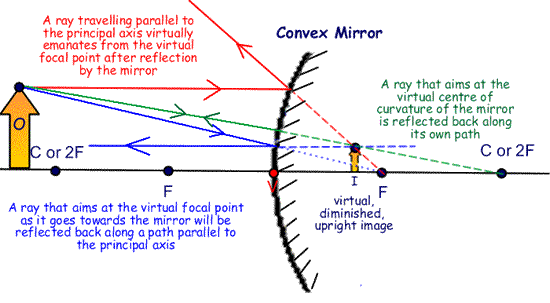
2. Object between C and F
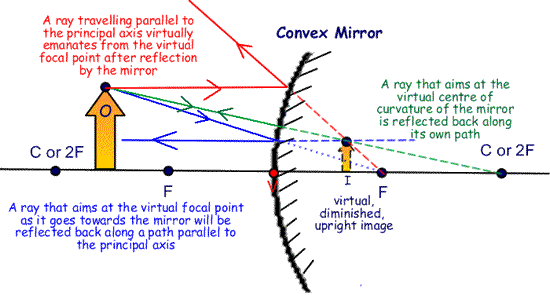
3. Object between F and V

4. Object at F

5. Object at C
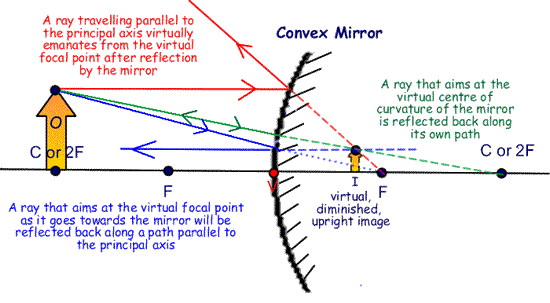
Uses of Convex Mirrors
Convex traffic safety mirrors are designed to assist road safety and can help eliminate blind spots at corners, concealed entrances and exits, car parks and junctions.
 Ceiling dome mirrors are Ideal for surveillance in shops, offices and industrial environments.They allow someone to watch what is going on in a wide area and allow shopkepers to spot theives and vandals.
Ceiling dome mirrors are Ideal for surveillance in shops, offices and industrial environments.They allow someone to watch what is going on in a wide area and allow shopkepers to spot theives and vandals. Cab front rear-view mirrors can be used to prevent forklift truck accidents. The panoramic view significantly reduces blind spots at the rear of the vehicle. The driver can see at a glance, and without excessive movement any obstacles as he/she reverses
Cab front rear-view mirrors can be used to prevent forklift truck accidents. The panoramic view significantly reduces blind spots at the rear of the vehicle. The driver can see at a glance, and without excessive movement any obstacles as he/she reverses

CONCAVE MIRROR
| Concave mirrors can be thought of as being made from the silvered inside of a sphere. If we took a sphere that was silvered on the inside and chopped off a section of it we would have a concave mirror. | 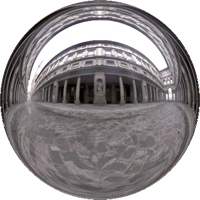 |
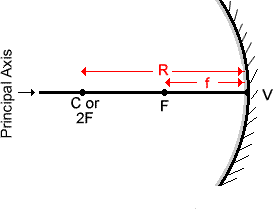 The line passing through the center of the sphere and attaching to the mirror in the exact center of the mirror is the principal axis. The point in the center of the sphere from which the mirror was sliced is known as the center of curvature and is denoted by the letter C . Sometimes a figure of 2F is used at this point.The point on the mirror's surface where the principal axis meets the mirror is known as the vertex - V. The vertex is the geometric center of the mirror. Midway between the vertex and the center of curvature is a point known as the focal point or principal focus ; the focal point is denoted by the letter F. The following facts are used to construc ray diagrams: The line passing through the center of the sphere and attaching to the mirror in the exact center of the mirror is the principal axis. The point in the center of the sphere from which the mirror was sliced is known as the center of curvature and is denoted by the letter C . Sometimes a figure of 2F is used at this point.The point on the mirror's surface where the principal axis meets the mirror is known as the vertex - V. The vertex is the geometric center of the mirror. Midway between the vertex and the center of curvature is a point known as the focal point or principal focus ; the focal point is denoted by the letter F. The following facts are used to construc ray diagrams: | |
| The distance from the vertex to the centre of curvature is called the radius of curvature (represented by R). The radius of curvature is the radius of the sphere from which the mirror was cut. The distance from the vertex to the focal point is known as the focal length - f. As the focal point is the midpoint of the line joining the vertex and the center of curvature, the focal length is one-half the radius of curvature. | |
We can use the following three facts to construct ray diagrams for curved mirrors:
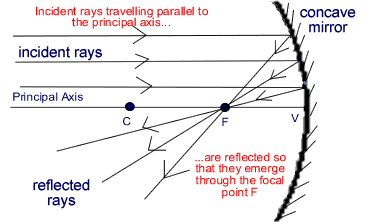
Any ray travelling parallel to the principal axis on its way to the mirror will pass through the focal point upon reflection.
Because the sun is such a large distance from the Earth, all light rays from the sun are travelling parallel to each other. If you make them travel along the principal axis they will be brought to a sharp focus. A concave mirror can therefore easily set alight objects such as curtains that happen to be at the focal point when the sun is shining onto the mirror. Therefore you usually see a warning sticker on such mirrors when you purchase them.
| |
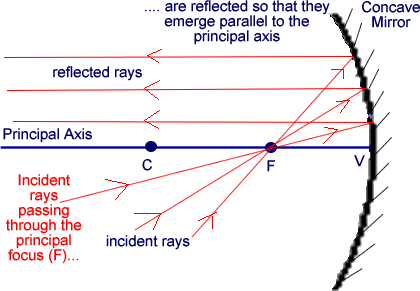
Any ray passing through the focal point on the way to the mirror will travel parallel to the princpal axis upon reflection.
Curved reflectors are used to make parallel rays of energy emerge from them. For example a curved reflector is used to give off parallel rays of infra red energy from the heating element of an electric fire. the heating element is placed at the focus and the rays that are reflected by the back of the fire come out in a parallel beam.
| |
Any ray that passes through the centre of curvature of the mirror will reflect back along its own path because the radius of a circle always hits the edge of the circle at 90 degrees - it hits it normally so the angle of incidence and reflection will both be zero.
|
Uses of Convex Mirrors
1.To focus sunlight for heating purpose
2.To have close look during shaving.
3.To produce parallel beam in car headlights.
4.Dentist end ENT doctors use it.
5.It is used in torches
No comments:
Post a Comment